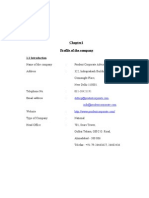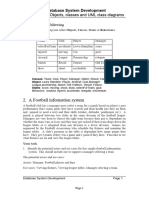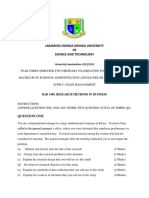Public Health Nutrtion
Public Health Nutrtion
Uploaded by
Kathlene GamitCopyright:
Available Formats
Public Health Nutrtion
Public Health Nutrtion
Uploaded by
Kathlene GamitOriginal Title
Copyright
Available Formats
Share this document
Did you find this document useful?
Is this content inappropriate?
Copyright:
Available Formats
Public Health Nutrtion
Public Health Nutrtion
Uploaded by
Kathlene GamitCopyright:
Available Formats
PUBLIC HEALTH NUTRTION THE CONCEPT OF HEALTH
Public Health – the science and art of preventing disease, The World Health Organization (WHO) defines HEALTH
prolonging life, and promoting health through organized as a state of complete physical, mental, and social well-
community. being, not merely the absence of disease.
“Ecological viewpoint”
Public Health Nutrition – theory and practice of nutrition; “anatomic integrity”
approach focuses on promotion of nutrition. Ability to perform personally valued family, work and
community roles.
Public Health Nutrition Program – planned nutrition activity in Ability to deal with physical, biological, and social stress.
the community.
Community – a group of people who are in a particular space, Determinants of Health
shared values, interact within social system. 1. Biology (sex, race, age, other hereditary factors)
2. Lifestyle (PA, diet, hobbies, use of drugs, religion, SP,
Policy – a course of action chosen by public authorities to medcare, stress mgnt)
address the problem. 3. Living, Working, and Social Conditions (housing,
education, occ, incm, soc net, soc econ stat)
Programs – instruments used by community nutritionist. 4. Community conditions (climate and geo, water suppl,
health, med, soc serv, political/gov)
Epidemiology- study of disease distribution within the 5. Background conditions (national foo, nut policy, national
population. min wage, cul belfs, Cul val, adv, media msgs, food dis
sys).
Nutritional epidemiology- application of epidemiological
techniques to understanding causes of disease in population.
NATURE OF PUBLIC HEALTH
Charles Edwars Winslow, American bacteriologist,
proponent of PH, define health as the science and the art
of preventing disease, prolonging life, promote physical
health and efficiency through organized community
efforts of sanitation of the environment.
Nutrition as a science is objective.
PHN gives emphasis to disease prevention and promote
well-being.
Community-based approach enable programs/interven o If not effective, drug therapy can recommend
to reach large number of people. o Strategies are aimed at self-care for people w/
Individuals and communities in environments need to be chronic disease
healthy.
Health care is basic to health. Tertiary Prevention (TP): Treatment and Rehabilitation
PHN is thought of as “going upstream’. o Involves treatment and rehab, reduced amount of
PHNP are cooperative social efforts. ↑ disability caused by disease
o Includes diabetes, kidney, angina
o Prevent further disability, any secondary
PREVENTION STRATEGIES IN PUBLIC HEALTH conditions that may result from health problems
3 LEVELS: o Ex: MNT for renal patient, Nut ed (vitamins & min
Primary Prevention (PP): Health Promotion suppl), feeding strat to prev HIV/AIDS, cardiac
o Strategies is encourage individuals, families and rehab (diet exercise, stress mngnt)
communities ways to reduce risk factors with o Goal: restore indv through rehab to an “optimal”
disease and injury. level.
o Methds: provide info to public, reach consumers
daily to promote nut intervention, provide CORE FUNCTIONS OF PUBLIC HEALTH
motivation for food services to serve ↓ fat, cal, Na. Assessment, Policy Development and Assurance
To endorse more complete food and nut labeling. Ten essential PH services identified by US Institute of
o Ex: Nut & weight mangt classes in comm center Med
for adults, environmental changes to provide nut 1. Monitor health status to identify com health prob.
choices in school caf vend machine. Campaigns to 2. Diagnose & investigate health prob and hazrds in
↑ avail of fruits and veg from farmer markets. com.
3. Inform, educate & empower people about health
Secondary Prevention (SP): Risk Appraisal and Risk issues.
reduction 4. Mobilize com partnership to identify and solve
o Risk appraisal and screening to emphasize early health prob.
detection and diag of disease. 5. Develop policies and plans
o Begins where patho may occur 6. Enforce laws and regulation to ensure safety
o Encompasses diagnostic services (screening, 7. Link people to needed personal health services
surveillance, clinical) (Adults: over 65, disabilities, diab)
o For people w/ cholesterol introduce to therapeutic 8. Assure competent ph and personal healthcare
lifestyle changes workplace
9. Evaluate effectiveness, accesbility and quality of Identify key nutrition related problem
personal and population based health services Set goal
10. Research for new insights and inov solutns to Define objective goals
health problems. Create quantitive
Develop program
Three Public Health approaches Implement program
1) Socio-ecological approach Evaluate program
Upstream approach
2) Lifestyle approach ROLES OF PUBLIC HEALTH NUTRITIONIST OR COMMUNITY
Disease prevention or midstream approach WORKER
3) Biological Approach 1. Assessor of people’s nutrition and nutrition related
Downstream or medical problems
2. Community organizer
Community Nutrition – is broader and encompasses any 3. Program planner
nut program which targets community, regardless it is 4. Program implementer
funded by gov or priv group 5. Community/group facilitator
Public Health- refers to community-based programs 6. Informer, educator, communicator
conducted by government agency. 7. Researcher
Nutrition epidemiology supports PHN, provides 8. Mediator
scientific basis for development of evidence on which ph 9. Program administrator
action can be implemented. 10. Program evaluator
o Goal: to inform PHN a population approach to 11. User of research and information
prevent illness and promote health through
nutrition. KNOWLEDGE AND SKILLS :
Health Promotion define as any process enables indv or Policy, Planning and administration
comm to increase control over determinants of their Biostatistics (collecting, compiling, analyzing, reporting)
health. Epidemiology (understand health and disease)
o Building healthy public policy Environment science (understand biological and chemical)
o Create supportive environment Research skills, Management, Communication, Education
o Dev personal skills of the public
o Reorienting health serv
o Strengthening community actions National Nutrition Policies
Guided by results of food and health surveys, give
THE PUBLIC HEALTH NUTRITION CYCLE information on distribution of foodstuff.
Exogenous factors- from outside (natural environment,
Methods of Acquiring Information man-made, behavioral)
1. Nutrition Assessment - measurement of indicators of Endogenous factors- from within (values, beliefs,
dietary status. attitudes, and knowledge)
2. Nutrition Monitoring – assessment of dietary at
intermittent times, detect changes in dietary. MALNUTRITION PROBLEMS IN PHILIPPINES
3. Nutrition surveillance- continuous assessment of 1. PROTEIN-ENERGY MALNUTRITION (PEM)/ PROTEIN-
nutritional status ENERGY UNDERNUTRITION (PEU)
4. Nutrition screening- system identifies specific Lack of protein and energy in diet
individuals for nutrition or public health intervention. Common in infancy/childhood and elderly
ET: Primary (inadequate food intake)
Secondary (low food ingestion, inadeq nut abs,
MALNUTRITION ↑nut req, ↑ nut losses)
Lack or absolute deficiency or excess of essential o Poverty, Ignorance, Social problems, Cul and
nutrients. Social Practices, Biological, Environmental.
Forms of Malnutrition: o Metabolic disruptions – caused by severe nutrient
1. Undernutrition- inadequate quantity of food, deficit complications or inadeq treatment.
micronutrient deficiency.
o Types: growth failure, wasting or edema, Clinical Forms of Acute Malnutrition
stunting, micronutrient deficiency Marasmus or Wasting
2. Overnutrition- excessive quantity of food o “skin and bones” appearance
3. Specific deficiency- results from relative lack or absolute o Thin “old man” face
deficiency of an individual nutrient. o Front view: ribs easily seen, skin upper arms lose
4. Imbalance- disproportion among essential nutrients and thighs
Acute Malnutrition (wasting or weight loss) Back view: ribs and shoulder is seen, flesh missing
Chronic Malnutrition (stunting) from buttocks “baggy pants”
o Class: Moderate acute malnutrition (MAM)
Severe acute malnutrition (SAM)
Body measurements: (MUAC & Weight-for-
Height)
ECOLOGY OF MALNUTRITION
Ecology- relationship of man to his environment or
factors influence man in what he does.
You might also like
- Katamino RulesDocument8 pagesKatamino RuleslejozsefNo ratings yet
- A Proposal On Reusable Sanitary PADSDocument16 pagesA Proposal On Reusable Sanitary PADSMike AbbeyNo ratings yet
- Flyers Reading and Writing Test 4 PDFDocument12 pagesFlyers Reading and Writing Test 4 PDFSorin Sotoc100% (1)
- CHN Module 1Document5 pagesCHN Module 1jaoNo ratings yet
- CPH Lec ReviewrDocument24 pagesCPH Lec ReviewrCresma Santa Rayjane DesamparoNo ratings yet
- Module 11Document136 pagesModule 11Birhanu Ayenew100% (1)
- Supple Question Community .Document10 pagesSupple Question Community .SP ShokhiNo ratings yet
- Home Economics II PresentationDocument22 pagesHome Economics II PresentationEmmanuel S JamesNo ratings yet
- Notes To Read 1Document4 pagesNotes To Read 1Rizzy UgayNo ratings yet
- Changing Concepts - 20240610 - 125440 - 0000Document56 pagesChanging Concepts - 20240610 - 125440 - 0000maniaformathNo ratings yet
- NR442 - Community Health Nursing - Exam 1 Study GuideDocument5 pagesNR442 - Community Health Nursing - Exam 1 Study GuideJohn Mixer100% (1)
- Primary Health Care ReviewerDocument5 pagesPrimary Health Care Reviewerabaderica111No ratings yet
- Dental Pub Health P MDocument10 pagesDental Pub Health P MShareinne TeamkNo ratings yet
- Dasar Kesehatan Masyarakat: Dian Ratna ElmaghfurohDocument39 pagesDasar Kesehatan Masyarakat: Dian Ratna ElmaghfurohFenny MellikeNo ratings yet
- FINALSDocument15 pagesFINALSmayangernszNo ratings yet
- 1.introduction To Public HealthDocument32 pages1.introduction To Public Healthwrite.medsyedsaadNo ratings yet
- CHN Concepts CompiledDocument81 pagesCHN Concepts CompiledTenIs ForMe0% (1)
- CHN Trans WK 2 4Document5 pagesCHN Trans WK 2 4cheskalyka.asiloNo ratings yet
- CHN 2 LectureDocument44 pagesCHN 2 Lectureandrea.maungca.mnlNo ratings yet
- Public Health Theory and ModelsDocument18 pagesPublic Health Theory and Modelsapi-573630044No ratings yet
- Overview of Public HealthDocument6 pagesOverview of Public Healthivan abuyuanNo ratings yet
- Lesson 2Document11 pagesLesson 2John Dave V. VillarmenteNo ratings yet
- W2 The Public Health Landscape, Social Determinants of Health and Health Disparities (Radix)Document36 pagesW2 The Public Health Landscape, Social Determinants of Health and Health Disparities (Radix)Jane de VriesNo ratings yet
- Public Health Components and Determinants of HealthDocument39 pagesPublic Health Components and Determinants of Healthsinthu2320100% (2)
- Pencegahan Penyakit, Kecacatan Dan Kematian Pada Gizi Kesehatan MasyarakatDocument24 pagesPencegahan Penyakit, Kecacatan Dan Kematian Pada Gizi Kesehatan MasyarakatWina MarthaliaNo ratings yet
- Introduction To Public Health ReviewerDocument4 pagesIntroduction To Public Health ReviewerVianne TabiqueNo ratings yet
- Introduction To Public HealthDocument10 pagesIntroduction To Public HealthJames RiosaNo ratings yet
- Public Health Lec MidtermDocument18 pagesPublic Health Lec MidtermCrystal CireraNo ratings yet
- Principles of Health Promotion: DR Celine MurrinDocument40 pagesPrinciples of Health Promotion: DR Celine MurrinKatie NolanNo ratings yet
- CommunityDocument8 pagesCommunityJared Elazegui EncioNo ratings yet
- Public HealthDocument3 pagesPublic HealthPhranxies Jean BlayaNo ratings yet
- CHN-Lecture Module 1 and 2Document64 pagesCHN-Lecture Module 1 and 2mirai desu100% (2)
- Unit 1Document39 pagesUnit 1Krista KloseNo ratings yet
- TOPIC 1 - What Is Public HealthDocument12 pagesTOPIC 1 - What Is Public HealthDebbie Iya Telacas BajentingNo ratings yet
- 1 Introduction To Public HealthDocument75 pages1 Introduction To Public HealthBrowsing IoNo ratings yet
- CHN in House Module 1Document7 pagesCHN in House Module 1Catherine AteradoNo ratings yet
- Public HealthDocument16 pagesPublic HealthCornelia Torrenueva Guiral ChavezNo ratings yet
- Community Health NursingDocument14 pagesCommunity Health NursingKira100% (13)
- Why Community Medicine?Document54 pagesWhy Community Medicine?Saher ShahzadNo ratings yet
- ID Pencegahan Dan Promosi Kesehatan Secara Tradisional Untuk Peningkatan Status MasDocument10 pagesID Pencegahan Dan Promosi Kesehatan Secara Tradisional Untuk Peningkatan Status MasFajar MNo ratings yet
- Community Health Nursing: World Views On CommunityDocument40 pagesCommunity Health Nursing: World Views On CommunityWreddit Regal100% (1)
- Introduction To Public HealthDocument23 pagesIntroduction To Public HealthNhial Nyachol BolNo ratings yet
- Introduction To Public Health (1 & 2)Document67 pagesIntroduction To Public Health (1 & 2)Abdulahi Bedel100% (1)
- Health Education Topic1Document4 pagesHealth Education Topic1Capuli, Rian Josh G.No ratings yet
- MATERI Keperawatan KomunitasDocument19 pagesMATERI Keperawatan KomunitasYetri MulizaNo ratings yet
- Public ('S) Nutrition: Micheline Beaudry and He Le'ne DelisleDocument6 pagesPublic ('S) Nutrition: Micheline Beaudry and He Le'ne DelislejorgeNo ratings yet
- Concept of PreventionDocument48 pagesConcept of Preventionmahmoud100% (1)
- CHNDocument136 pagesCHNSapiah RamanNo ratings yet
- Group 2 - Framework of PreventionDocument29 pagesGroup 2 - Framework of PreventionAdiel CalsaNo ratings yet
- Introduction To Health Promotion and Health Education - Dr. ElizabethDocument33 pagesIntroduction To Health Promotion and Health Education - Dr. ElizabethArnold Dickens JosephNo ratings yet
- Community Health Nursing: An OverviewDocument5 pagesCommunity Health Nursing: An OverviewKhylamarie VillalunaNo ratings yet
- Public Health MPHDocument45 pagesPublic Health MPHInayat UllahNo ratings yet
- PBH101 - Lecture 1 - Concept of Health, Public Health and PHC - 2023 - SKMFDocument40 pagesPBH101 - Lecture 1 - Concept of Health, Public Health and PHC - 2023 - SKMFZahin KhanNo ratings yet
- The Cult and Science of Public Health: A Sociological InvestigationFrom EverandThe Cult and Science of Public Health: A Sociological InvestigationNo ratings yet
- The Inside Tract: Your Good Gut Guide to Great Digestive HealthFrom EverandThe Inside Tract: Your Good Gut Guide to Great Digestive HealthNo ratings yet
- Preventing Illness: Revolutionary StrategiesEmpowering Your Journey to Wellness through Science and Innovation for a Healthier Tomorrow:From EverandPreventing Illness: Revolutionary StrategiesEmpowering Your Journey to Wellness through Science and Innovation for a Healthier Tomorrow:No ratings yet
- UntitledDocument107 pagesUntitledKathlene GamitNo ratings yet
- VheeeeDocument50 pagesVheeeeKathlene GamitNo ratings yet
- Renal Computation AssessmentDocument7 pagesRenal Computation AssessmentKathlene GamitNo ratings yet
- About The Lecturer: Southern Philippines Medical Center Nutrition and Dietetics ServiceDocument71 pagesAbout The Lecturer: Southern Philippines Medical Center Nutrition and Dietetics ServiceKathlene GamitNo ratings yet
- Renal Exchange List KardexDocument2 pagesRenal Exchange List KardexKathlene GamitNo ratings yet
- MNT Empty FormDocument2 pagesMNT Empty FormKathlene GamitNo ratings yet
- Food Service Workshop PPT2 1Document72 pagesFood Service Workshop PPT2 1Kathlene GamitNo ratings yet
- Malnutrition-Induced Neurologic DisordersDocument196 pagesMalnutrition-Induced Neurologic DisordersKathlene GamitNo ratings yet
- Chapter 2 - NT2Document25 pagesChapter 2 - NT2Kathlene GamitNo ratings yet
- Alternative TherapiesDocument18 pagesAlternative TherapiesKathlene GamitNo ratings yet
- Amended Texas Roadhouse ComplaintDocument70 pagesAmended Texas Roadhouse ComplaintLydia DePillisNo ratings yet
- Employee Training and Development Has Emerged As A Major Educational Enterprise Over The Past Three DecadesDocument12 pagesEmployee Training and Development Has Emerged As A Major Educational Enterprise Over The Past Three Decadesmuna moonoNo ratings yet
- INTRODUCTIONDocument2 pagesINTRODUCTIONEldonVinceIsidroNo ratings yet
- English 2 - Q3-M4 - 2021-2022Document20 pagesEnglish 2 - Q3-M4 - 2021-2022RUBY ABAQUITANo ratings yet
- Profile of The CompanyDocument44 pagesProfile of The CompanyVijay NautiyalNo ratings yet
- Tutorial StocksDocument3 pagesTutorial StocksNguyên KhôiNo ratings yet
- Believer (Imagine Dragons) - 2017Document1 pageBeliever (Imagine Dragons) - 2017James DerekNo ratings yet
- Education 12 00166 With CoverDocument26 pagesEducation 12 00166 With Covercixemey590No ratings yet
- National Comprehensive Agriculture Development Priority Program 2016 - 2021Document45 pagesNational Comprehensive Agriculture Development Priority Program 2016 - 2021wafiullah sayedNo ratings yet
- Global Fruit & Vegetables Processing: Ibisworld Industry ReportDocument39 pagesGlobal Fruit & Vegetables Processing: Ibisworld Industry ReportChin Kai WenNo ratings yet
- No. Fouls: Captain's Signature in Case of ProtestDocument1 pageNo. Fouls: Captain's Signature in Case of ProtestFaith Wang100% (1)
- 9akk106354a3359 Emergi-Lite Uk 2020 CT DGTDocument152 pages9akk106354a3359 Emergi-Lite Uk 2020 CT DGTOjog Ciprian AlinNo ratings yet
- Spirituality in Architecture For IndDocument24 pagesSpirituality in Architecture For Indgkavin616No ratings yet
- How To Prevent Sexual Harassment in The WorkplaceDocument20 pagesHow To Prevent Sexual Harassment in The WorkplaceSyah YunusNo ratings yet
- DCC3113 - Chapter 5 PDFDocument24 pagesDCC3113 - Chapter 5 PDFXkarr Rasta100% (1)
- ThiveDocument1 pageThiveCotton LogicNo ratings yet
- 31589H Sifflet T Activity1Document7 pages31589H Sifflet T Activity1Chenaulde BoukouNo ratings yet
- Agrobacterium ProtocolsDocument372 pagesAgrobacterium ProtocolsBen100% (1)
- 4UFM E3 LO3 Resource v2Document19 pages4UFM E3 LO3 Resource v2Ruchira PereraNo ratings yet
- Positive Aspects of Phil. ValuesDocument13 pagesPositive Aspects of Phil. ValuesJaymar MagtibayNo ratings yet
- Ethnicity in India PDFDocument2 pagesEthnicity in India PDFAustinNo ratings yet
- Unit 9 Test: Speaking: Photo DescriptionDocument1 pageUnit 9 Test: Speaking: Photo DescriptionTTNLittleGeniusNo ratings yet
- SD Tutorial ClassesStudentsDocument4 pagesSD Tutorial ClassesStudents36. Nguyễn Thanh SơnNo ratings yet
- Bab 1308 Research Methods in BusinessDocument2 pagesBab 1308 Research Methods in Businesskuriamartin20No ratings yet
- Course Outcome 1 Study MaterialsDocument16 pagesCourse Outcome 1 Study MaterialsWhoAre YouNo ratings yet
- UG Model QP MergedDocument93 pagesUG Model QP MergedvineethkmenonNo ratings yet
- Benchmarking of Oneplus-76Document11 pagesBenchmarking of Oneplus-76Hemasri ChinnuNo ratings yet



































































































